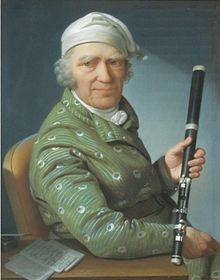The Tromlitz flute, invented in 1785 preceded the saxophone by 55 years and was the first flute to be able to play all major and minor semitones of 5 and 4 commas, meaning it had no limitations playing all the different flats and sharps in the 24-note octave of, say, Just Intonation. For instance, Mozart wrote his flute pieces using different values for sharps and flats (as everyone did, that's all that was known at the time). A good flautist was adept at playing them fluently, and an average player failed to discriminate, thus rendering the compositions weak and insipid, devoid of the true tonal colourings the Master intended. Not that I like much classical music. But they're now saying it sounds crap unless it is performed using the temperament of the period it was composed in. Makes sense.
In the 19th century most contemporary musicians and composers were moving from various meantone eg ¼comma to well-temperaments like Werckmeister and Kirnberger, but still the different size semitones were still indispensable for playing pure thirds etc. Many people don't realise or are mistaken in thinking that Equal Temperament was widespread at the time. As far as pianos go, it was in fact Quasi-equal temperament because until 1917 there hadn't been a foolproof method for tuning ET - other than fretted instruments, which to this day still approximate the ancient "Rule of 18" to position the frets. (27" scale, ÷ 18 = first fret 1½" from the nut, therefore 2nd fret is 25.5"÷18 = 1.41666666" etc. The Indians and the Chinese have been doing it this way since the year dot)
So my question is, like the Tromlitz flute, do saxophones have special fingerings for small and large semitones to accommodate sharps (which are slightly flatter) and flats (which are slightly sharper), as in G# Ab, or is all this adjusted randomly by embouchure? (before I lost my right index finger, when I played the flute I used the simpler, slightly off-key incorrect fingering to play E, the same as Ian Anderson. According to his website, he was corrected later in his career by his daughter!)
So I'm assuming that the Saxophone, like most instruments made before the 20th Century, were not crafted to play in Equal Temperament. Even early keyboards had split black keys for playing either sharps or flats, and were tuned with temperaments that didn't facilitate modulation to all keys.
Man, I dig those pure thirds! If I put my keyboard in Equal Temperament it lasts about 15 seconds before I switch it back. My default is to Kirnberger III for modern music requiring the usual amount of modulation but for anything that only uses the 8 pure majors I absolutely love ¼comma meantone (Eb, Bb, F, C, G, D, A, and E, all major chords). Only rarely do I notice the narrow fifths of about 4 or 5 cents. It doesn't seem to bug me, but I can no longer stand the impure major third of Equal Temperament which is a whopping 13.7 cents sharp. It's about as pretty as a hat full of arseholes.


No comments:
Post a Comment